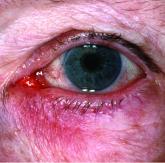Managing ocular rosacea often includes a combination of oral and topical treatments, and some patients find relief with natural strategies such as warm compresses and eyelid massage, Julie C. Harper, MD, said at the Skin Disease Education Foundation’s annual Las Vegas Dermatology Seminar.
Ocular rosacea can present in several forms, including sties on the eyelids, blepharitis with chalazia and telangiectasia, and “meibomian inspissation visible as pale streaks perpendicular to the lid margin,” according to a 2016 review article she cited (Clin Dermatol. 2016 Mar-Apr;34[2]:146-50).
In a randomized trial of 38 adult patients with ocular rosacea treated with topical cyclosporine (twice a day for 3 months) or oral doxycycline (100 mg twice a day for 1 month, followed by 100 mg once a day for 2 months), posttreatment symptom scores showed similarly significant improvements for both topical cyclosporine and oral doxycycline (Int J Ophthalmol. 2015 Jun 18;8[3]:544-9). However, “cyclosporine was found to be more effective in symptomatic relief and treatment of eyelid signs,” said Dr. Harper, a dermatologist in private practice in Birmingham, Ala.The most common symptoms at baseline were burning, stinging, and light sensitivity. At baseline, all the cyclosporine-treated patients had burning, stinging, and light sensitivity, which dropped to 21%, 47%, and 10.5% of the patients, respectively, after 3 months of twice-daily topical treatment. In the study, all patients also were administering artificial eye drops daily.
The patients treated with doxycycline also showed improvement in these three symptoms after 3 months of treatment, but not to the same degree: At 3 months, 74% still had burning and stinging, from 100% at baseline. Almost 95% had light sensitivity at baseline, dropping to 21% after 3 months of treatment.
When treating patients with ocular rosacea, “the greatest challenge is that we don’t have any medications that are Food and Drug Administration–approved for this indication,” Dr. Harper said in an interview.
In the interview, she provided the following pearl: “Always ask about eye involvement in rosacea patients; they won’t volunteer information because they think it is unrelated. Teach patients about lid care (lid massage and artificial tears). This is analogous to good skin care in cutaneous rosacea.”
Dr. Harper disclosed serving as a speaker/adviser for Allergan, Bayer, and Galderma, and receiving research support from Bayer. SDEF and this news organization are owned by the same parent company.
dermnews@frontlinemedcom.com
